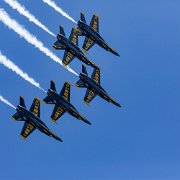
1 Detroit - Blue Angels
The Blue Angels flight demonstration squadron was formed in 1946 by the United States Navy. The unit is the second oldest formal aerobatic team (under the same name) in the world, after the French Patrouille de France formed in 1931. The Blue Angels' McDonnell Douglas F/A-18 Hornets (numbered 1–6) are currently flown by five Navy demonstration pilots and one Marine Corps demonstration pilot.
The Blue Angels typically perform aerial displays annually in at least 60 shows at 30 locations throughout the United States and two shows at one location in Canada. The "Blues" still employ many of the same practices and techniques used in the inaugural 1946 season. An estimated 11 million spectators view the squadron during air shows from March through November each year. Members of the Blue Angels team also visit more than 50,000 people in schools, hospitals, and community functions at air show cities. Since 1946, the Blue Angels have flown for more than 505 million spectators.
The Blue Angels flight demonstration squadron was formed in 1946 by the United States Navy. The unit is the second oldest formal aerobatic team (under the same name) in the world, after the French Patrouille de France formed in 1931. The Blue Angels' McDonnell Douglas F/A-18 Hornets (numbered 1–6) are currently flown by five Navy demonstration pilots and one Marine Corps demonstration pilot.
The Blue Angels typically perform aerial displays annually in at least 60 shows at 30 locations throughout the United States and two shows at one location in Canada. The "Blues" still employ many of the same practices and techniques used in the inaugural 1946 season. An estimated 11 million spectators view the squadron during air shows from March through November each year. Members of the Blue Angels team also visit more than 50,000 people in schools, hospitals, and community functions at air show cities. Since 1946, the Blue Angels have flown for more than 505 million spectators.
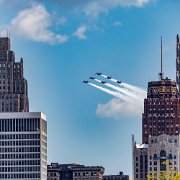
2 Detroit - Blue Angels
The Blue Angels flight demonstration squadron was formed in 1946 by the United States Navy. The unit is the second oldest formal aerobatic team (under the same name) in the world, after the French Patrouille de France formed in 1931. The Blue Angels' McDonnell Douglas F/A-18 Hornets (numbered 1–6) are currently flown by five Navy demonstration pilots and one Marine Corps demonstration pilot.
The Blue Angels typically perform aerial displays annually in at least 60 shows at 30 locations throughout the United States and two shows at one location in Canada. The "Blues" still employ many of the same practices and techniques used in the inaugural 1946 season. An estimated 11 million spectators view the squadron during air shows from March through November each year. Members of the Blue Angels team also visit more than 50,000 people in schools, hospitals, and community functions at air show cities. Since 1946, the Blue Angels have flown for more than 505 million spectators.
The Blue Angels flight demonstration squadron was formed in 1946 by the United States Navy. The unit is the second oldest formal aerobatic team (under the same name) in the world, after the French Patrouille de France formed in 1931. The Blue Angels' McDonnell Douglas F/A-18 Hornets (numbered 1–6) are currently flown by five Navy demonstration pilots and one Marine Corps demonstration pilot.
The Blue Angels typically perform aerial displays annually in at least 60 shows at 30 locations throughout the United States and two shows at one location in Canada. The "Blues" still employ many of the same practices and techniques used in the inaugural 1946 season. An estimated 11 million spectators view the squadron during air shows from March through November each year. Members of the Blue Angels team also visit more than 50,000 people in schools, hospitals, and community functions at air show cities. Since 1946, the Blue Angels have flown for more than 505 million spectators.
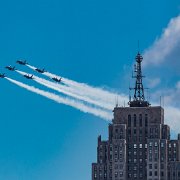
3 Detroit - Blue Angels
The Blue Angels flight demonstration squadron was formed in 1946 by the United States Navy. The unit is the second oldest formal aerobatic team (under the same name) in the world, after the French Patrouille de France formed in 1931. The Blue Angels' McDonnell Douglas F/A-18 Hornets (numbered 1–6) are currently flown by five Navy demonstration pilots and one Marine Corps demonstration pilot.
The Blue Angels typically perform aerial displays annually in at least 60 shows at 30 locations throughout the United States and two shows at one location in Canada. The "Blues" still employ many of the same practices and techniques used in the inaugural 1946 season. An estimated 11 million spectators view the squadron during air shows from March through November each year. Members of the Blue Angels team also visit more than 50,000 people in schools, hospitals, and community functions at air show cities. Since 1946, the Blue Angels have flown for more than 505 million spectators.
The Blue Angels flight demonstration squadron was formed in 1946 by the United States Navy. The unit is the second oldest formal aerobatic team (under the same name) in the world, after the French Patrouille de France formed in 1931. The Blue Angels' McDonnell Douglas F/A-18 Hornets (numbered 1–6) are currently flown by five Navy demonstration pilots and one Marine Corps demonstration pilot.
The Blue Angels typically perform aerial displays annually in at least 60 shows at 30 locations throughout the United States and two shows at one location in Canada. The "Blues" still employ many of the same practices and techniques used in the inaugural 1946 season. An estimated 11 million spectators view the squadron during air shows from March through November each year. Members of the Blue Angels team also visit more than 50,000 people in schools, hospitals, and community functions at air show cities. Since 1946, the Blue Angels have flown for more than 505 million spectators.
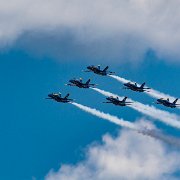
4 Detroit - Blue Angels
The Blue Angels flight demonstration squadron was formed in 1946 by the United States Navy. The unit is the second oldest formal aerobatic team (under the same name) in the world, after the French Patrouille de France formed in 1931. The Blue Angels' McDonnell Douglas F/A-18 Hornets (numbered 1–6) are currently flown by five Navy demonstration pilots and one Marine Corps demonstration pilot.
The Blue Angels typically perform aerial displays annually in at least 60 shows at 30 locations throughout the United States and two shows at one location in Canada. The "Blues" still employ many of the same practices and techniques used in the inaugural 1946 season. An estimated 11 million spectators view the squadron during air shows from March through November each year. Members of the Blue Angels team also visit more than 50,000 people in schools, hospitals, and community functions at air show cities. Since 1946, the Blue Angels have flown for more than 505 million spectators.
The Blue Angels flight demonstration squadron was formed in 1946 by the United States Navy. The unit is the second oldest formal aerobatic team (under the same name) in the world, after the French Patrouille de France formed in 1931. The Blue Angels' McDonnell Douglas F/A-18 Hornets (numbered 1–6) are currently flown by five Navy demonstration pilots and one Marine Corps demonstration pilot.
The Blue Angels typically perform aerial displays annually in at least 60 shows at 30 locations throughout the United States and two shows at one location in Canada. The "Blues" still employ many of the same practices and techniques used in the inaugural 1946 season. An estimated 11 million spectators view the squadron during air shows from March through November each year. Members of the Blue Angels team also visit more than 50,000 people in schools, hospitals, and community functions at air show cities. Since 1946, the Blue Angels have flown for more than 505 million spectators.
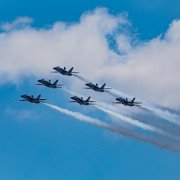
5 Detroit - Blue Angels
The Blue Angels flight demonstration squadron was formed in 1946 by the United States Navy. The unit is the second oldest formal aerobatic team (under the same name) in the world, after the French Patrouille de France formed in 1931. The Blue Angels' McDonnell Douglas F/A-18 Hornets (numbered 1–6) are currently flown by five Navy demonstration pilots and one Marine Corps demonstration pilot.
The Blue Angels typically perform aerial displays annually in at least 60 shows at 30 locations throughout the United States and two shows at one location in Canada. The "Blues" still employ many of the same practices and techniques used in the inaugural 1946 season. An estimated 11 million spectators view the squadron during air shows from March through November each year. Members of the Blue Angels team also visit more than 50,000 people in schools, hospitals, and community functions at air show cities. Since 1946, the Blue Angels have flown for more than 505 million spectators.
The Blue Angels flight demonstration squadron was formed in 1946 by the United States Navy. The unit is the second oldest formal aerobatic team (under the same name) in the world, after the French Patrouille de France formed in 1931. The Blue Angels' McDonnell Douglas F/A-18 Hornets (numbered 1–6) are currently flown by five Navy demonstration pilots and one Marine Corps demonstration pilot.
The Blue Angels typically perform aerial displays annually in at least 60 shows at 30 locations throughout the United States and two shows at one location in Canada. The "Blues" still employ many of the same practices and techniques used in the inaugural 1946 season. An estimated 11 million spectators view the squadron during air shows from March through November each year. Members of the Blue Angels team also visit more than 50,000 people in schools, hospitals, and community functions at air show cities. Since 1946, the Blue Angels have flown for more than 505 million spectators.
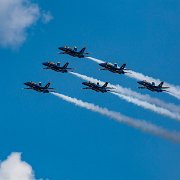
6 Detroit - Blue Angels
The Blue Angels flight demonstration squadron was formed in 1946 by the United States Navy. The unit is the second oldest formal aerobatic team (under the same name) in the world, after the French Patrouille de France formed in 1931. The Blue Angels' McDonnell Douglas F/A-18 Hornets (numbered 1–6) are currently flown by five Navy demonstration pilots and one Marine Corps demonstration pilot.
The Blue Angels typically perform aerial displays annually in at least 60 shows at 30 locations throughout the United States and two shows at one location in Canada. The "Blues" still employ many of the same practices and techniques used in the inaugural 1946 season. An estimated 11 million spectators view the squadron during air shows from March through November each year. Members of the Blue Angels team also visit more than 50,000 people in schools, hospitals, and community functions at air show cities. Since 1946, the Blue Angels have flown for more than 505 million spectators.
The Blue Angels flight demonstration squadron was formed in 1946 by the United States Navy. The unit is the second oldest formal aerobatic team (under the same name) in the world, after the French Patrouille de France formed in 1931. The Blue Angels' McDonnell Douglas F/A-18 Hornets (numbered 1–6) are currently flown by five Navy demonstration pilots and one Marine Corps demonstration pilot.
The Blue Angels typically perform aerial displays annually in at least 60 shows at 30 locations throughout the United States and two shows at one location in Canada. The "Blues" still employ many of the same practices and techniques used in the inaugural 1946 season. An estimated 11 million spectators view the squadron during air shows from March through November each year. Members of the Blue Angels team also visit more than 50,000 people in schools, hospitals, and community functions at air show cities. Since 1946, the Blue Angels have flown for more than 505 million spectators.
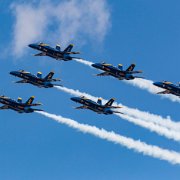
7 Detroit - Blue Angels
The Blue Angels flight demonstration squadron was formed in 1946 by the United States Navy. The unit is the second oldest formal aerobatic team (under the same name) in the world, after the French Patrouille de France formed in 1931. The Blue Angels' McDonnell Douglas F/A-18 Hornets (numbered 1–6) are currently flown by five Navy demonstration pilots and one Marine Corps demonstration pilot.
The Blue Angels typically perform aerial displays annually in at least 60 shows at 30 locations throughout the United States and two shows at one location in Canada. The "Blues" still employ many of the same practices and techniques used in the inaugural 1946 season. An estimated 11 million spectators view the squadron during air shows from March through November each year. Members of the Blue Angels team also visit more than 50,000 people in schools, hospitals, and community functions at air show cities. Since 1946, the Blue Angels have flown for more than 505 million spectators.
The Blue Angels flight demonstration squadron was formed in 1946 by the United States Navy. The unit is the second oldest formal aerobatic team (under the same name) in the world, after the French Patrouille de France formed in 1931. The Blue Angels' McDonnell Douglas F/A-18 Hornets (numbered 1–6) are currently flown by five Navy demonstration pilots and one Marine Corps demonstration pilot.
The Blue Angels typically perform aerial displays annually in at least 60 shows at 30 locations throughout the United States and two shows at one location in Canada. The "Blues" still employ many of the same practices and techniques used in the inaugural 1946 season. An estimated 11 million spectators view the squadron during air shows from March through November each year. Members of the Blue Angels team also visit more than 50,000 people in schools, hospitals, and community functions at air show cities. Since 1946, the Blue Angels have flown for more than 505 million spectators.
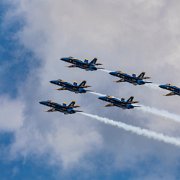
8 Detroit - Blue Angels
The Blue Angels flight demonstration squadron was formed in 1946 by the United States Navy. The unit is the second oldest formal aerobatic team (under the same name) in the world, after the French Patrouille de France formed in 1931. The Blue Angels' McDonnell Douglas F/A-18 Hornets (numbered 1–6) are currently flown by five Navy demonstration pilots and one Marine Corps demonstration pilot.
The Blue Angels typically perform aerial displays annually in at least 60 shows at 30 locations throughout the United States and two shows at one location in Canada. The "Blues" still employ many of the same practices and techniques used in the inaugural 1946 season. An estimated 11 million spectators view the squadron during air shows from March through November each year. Members of the Blue Angels team also visit more than 50,000 people in schools, hospitals, and community functions at air show cities. Since 1946, the Blue Angels have flown for more than 505 million spectators.
The Blue Angels flight demonstration squadron was formed in 1946 by the United States Navy. The unit is the second oldest formal aerobatic team (under the same name) in the world, after the French Patrouille de France formed in 1931. The Blue Angels' McDonnell Douglas F/A-18 Hornets (numbered 1–6) are currently flown by five Navy demonstration pilots and one Marine Corps demonstration pilot.
The Blue Angels typically perform aerial displays annually in at least 60 shows at 30 locations throughout the United States and two shows at one location in Canada. The "Blues" still employ many of the same practices and techniques used in the inaugural 1946 season. An estimated 11 million spectators view the squadron during air shows from March through November each year. Members of the Blue Angels team also visit more than 50,000 people in schools, hospitals, and community functions at air show cities. Since 1946, the Blue Angels have flown for more than 505 million spectators.
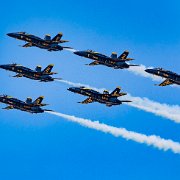
9 Detroit - Blue Angels
The Blue Angels flight demonstration squadron was formed in 1946 by the United States Navy. The unit is the second oldest formal aerobatic team (under the same name) in the world, after the French Patrouille de France formed in 1931. The Blue Angels' McDonnell Douglas F/A-18 Hornets (numbered 1–6) are currently flown by five Navy demonstration pilots and one Marine Corps demonstration pilot.
The Blue Angels typically perform aerial displays annually in at least 60 shows at 30 locations throughout the United States and two shows at one location in Canada. The "Blues" still employ many of the same practices and techniques used in the inaugural 1946 season. An estimated 11 million spectators view the squadron during air shows from March through November each year. Members of the Blue Angels team also visit more than 50,000 people in schools, hospitals, and community functions at air show cities. Since 1946, the Blue Angels have flown for more than 505 million spectators.
The Blue Angels flight demonstration squadron was formed in 1946 by the United States Navy. The unit is the second oldest formal aerobatic team (under the same name) in the world, after the French Patrouille de France formed in 1931. The Blue Angels' McDonnell Douglas F/A-18 Hornets (numbered 1–6) are currently flown by five Navy demonstration pilots and one Marine Corps demonstration pilot.
The Blue Angels typically perform aerial displays annually in at least 60 shows at 30 locations throughout the United States and two shows at one location in Canada. The "Blues" still employ many of the same practices and techniques used in the inaugural 1946 season. An estimated 11 million spectators view the squadron during air shows from March through November each year. Members of the Blue Angels team also visit more than 50,000 people in schools, hospitals, and community functions at air show cities. Since 1946, the Blue Angels have flown for more than 505 million spectators.
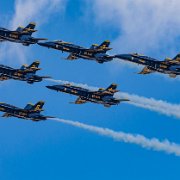
10 Detroit - Blue Angels
The Blue Angels flight demonstration squadron was formed in 1946 by the United States Navy. The unit is the second oldest formal aerobatic team (under the same name) in the world, after the French Patrouille de France formed in 1931. The Blue Angels' McDonnell Douglas F/A-18 Hornets (numbered 1–6) are currently flown by five Navy demonstration pilots and one Marine Corps demonstration pilot.
The Blue Angels typically perform aerial displays annually in at least 60 shows at 30 locations throughout the United States and two shows at one location in Canada. The "Blues" still employ many of the same practices and techniques used in the inaugural 1946 season. An estimated 11 million spectators view the squadron during air shows from March through November each year. Members of the Blue Angels team also visit more than 50,000 people in schools, hospitals, and community functions at air show cities. Since 1946, the Blue Angels have flown for more than 505 million spectators.
The Blue Angels flight demonstration squadron was formed in 1946 by the United States Navy. The unit is the second oldest formal aerobatic team (under the same name) in the world, after the French Patrouille de France formed in 1931. The Blue Angels' McDonnell Douglas F/A-18 Hornets (numbered 1–6) are currently flown by five Navy demonstration pilots and one Marine Corps demonstration pilot.
The Blue Angels typically perform aerial displays annually in at least 60 shows at 30 locations throughout the United States and two shows at one location in Canada. The "Blues" still employ many of the same practices and techniques used in the inaugural 1946 season. An estimated 11 million spectators view the squadron during air shows from March through November each year. Members of the Blue Angels team also visit more than 50,000 people in schools, hospitals, and community functions at air show cities. Since 1946, the Blue Angels have flown for more than 505 million spectators.
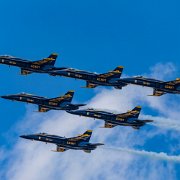
11 Detroit - Blue Angels
The Blue Angels flight demonstration squadron was formed in 1946 by the United States Navy. The unit is the second oldest formal aerobatic team (under the same name) in the world, after the French Patrouille de France formed in 1931. The Blue Angels' McDonnell Douglas F/A-18 Hornets (numbered 1–6) are currently flown by five Navy demonstration pilots and one Marine Corps demonstration pilot.
The Blue Angels typically perform aerial displays annually in at least 60 shows at 30 locations throughout the United States and two shows at one location in Canada. The "Blues" still employ many of the same practices and techniques used in the inaugural 1946 season. An estimated 11 million spectators view the squadron during air shows from March through November each year. Members of the Blue Angels team also visit more than 50,000 people in schools, hospitals, and community functions at air show cities. Since 1946, the Blue Angels have flown for more than 505 million spectators.
The Blue Angels flight demonstration squadron was formed in 1946 by the United States Navy. The unit is the second oldest formal aerobatic team (under the same name) in the world, after the French Patrouille de France formed in 1931. The Blue Angels' McDonnell Douglas F/A-18 Hornets (numbered 1–6) are currently flown by five Navy demonstration pilots and one Marine Corps demonstration pilot.
The Blue Angels typically perform aerial displays annually in at least 60 shows at 30 locations throughout the United States and two shows at one location in Canada. The "Blues" still employ many of the same practices and techniques used in the inaugural 1946 season. An estimated 11 million spectators view the squadron during air shows from March through November each year. Members of the Blue Angels team also visit more than 50,000 people in schools, hospitals, and community functions at air show cities. Since 1946, the Blue Angels have flown for more than 505 million spectators.
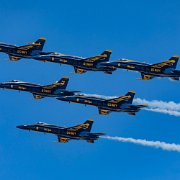
12 Detroit - Blue Angels
The Blue Angels flight demonstration squadron was formed in 1946 by the United States Navy. The unit is the second oldest formal aerobatic team (under the same name) in the world, after the French Patrouille de France formed in 1931. The Blue Angels' McDonnell Douglas F/A-18 Hornets (numbered 1–6) are currently flown by five Navy demonstration pilots and one Marine Corps demonstration pilot.
The Blue Angels typically perform aerial displays annually in at least 60 shows at 30 locations throughout the United States and two shows at one location in Canada. The "Blues" still employ many of the same practices and techniques used in the inaugural 1946 season. An estimated 11 million spectators view the squadron during air shows from March through November each year. Members of the Blue Angels team also visit more than 50,000 people in schools, hospitals, and community functions at air show cities. Since 1946, the Blue Angels have flown for more than 505 million spectators.
The Blue Angels flight demonstration squadron was formed in 1946 by the United States Navy. The unit is the second oldest formal aerobatic team (under the same name) in the world, after the French Patrouille de France formed in 1931. The Blue Angels' McDonnell Douglas F/A-18 Hornets (numbered 1–6) are currently flown by five Navy demonstration pilots and one Marine Corps demonstration pilot.
The Blue Angels typically perform aerial displays annually in at least 60 shows at 30 locations throughout the United States and two shows at one location in Canada. The "Blues" still employ many of the same practices and techniques used in the inaugural 1946 season. An estimated 11 million spectators view the squadron during air shows from March through November each year. Members of the Blue Angels team also visit more than 50,000 people in schools, hospitals, and community functions at air show cities. Since 1946, the Blue Angels have flown for more than 505 million spectators.
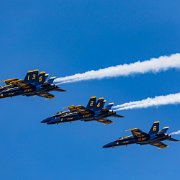
13 Detroit - Blue Angels
The Blue Angels flight demonstration squadron was formed in 1946 by the United States Navy. The unit is the second oldest formal aerobatic team (under the same name) in the world, after the French Patrouille de France formed in 1931. The Blue Angels' McDonnell Douglas F/A-18 Hornets (numbered 1–6) are currently flown by five Navy demonstration pilots and one Marine Corps demonstration pilot.
The Blue Angels typically perform aerial displays annually in at least 60 shows at 30 locations throughout the United States and two shows at one location in Canada. The "Blues" still employ many of the same practices and techniques used in the inaugural 1946 season. An estimated 11 million spectators view the squadron during air shows from March through November each year. Members of the Blue Angels team also visit more than 50,000 people in schools, hospitals, and community functions at air show cities. Since 1946, the Blue Angels have flown for more than 505 million spectators.
The Blue Angels flight demonstration squadron was formed in 1946 by the United States Navy. The unit is the second oldest formal aerobatic team (under the same name) in the world, after the French Patrouille de France formed in 1931. The Blue Angels' McDonnell Douglas F/A-18 Hornets (numbered 1–6) are currently flown by five Navy demonstration pilots and one Marine Corps demonstration pilot.
The Blue Angels typically perform aerial displays annually in at least 60 shows at 30 locations throughout the United States and two shows at one location in Canada. The "Blues" still employ many of the same practices and techniques used in the inaugural 1946 season. An estimated 11 million spectators view the squadron during air shows from March through November each year. Members of the Blue Angels team also visit more than 50,000 people in schools, hospitals, and community functions at air show cities. Since 1946, the Blue Angels have flown for more than 505 million spectators.
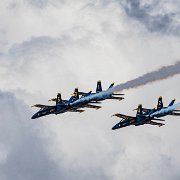
14 Detroit - Blue Angels
The Blue Angels flight demonstration squadron was formed in 1946 by the United States Navy. The unit is the second oldest formal aerobatic team (under the same name) in the world, after the French Patrouille de France formed in 1931. The Blue Angels' McDonnell Douglas F/A-18 Hornets (numbered 1–6) are currently flown by five Navy demonstration pilots and one Marine Corps demonstration pilot.
The Blue Angels typically perform aerial displays annually in at least 60 shows at 30 locations throughout the United States and two shows at one location in Canada. The "Blues" still employ many of the same practices and techniques used in the inaugural 1946 season. An estimated 11 million spectators view the squadron during air shows from March through November each year. Members of the Blue Angels team also visit more than 50,000 people in schools, hospitals, and community functions at air show cities. Since 1946, the Blue Angels have flown for more than 505 million spectators.
The Blue Angels flight demonstration squadron was formed in 1946 by the United States Navy. The unit is the second oldest formal aerobatic team (under the same name) in the world, after the French Patrouille de France formed in 1931. The Blue Angels' McDonnell Douglas F/A-18 Hornets (numbered 1–6) are currently flown by five Navy demonstration pilots and one Marine Corps demonstration pilot.
The Blue Angels typically perform aerial displays annually in at least 60 shows at 30 locations throughout the United States and two shows at one location in Canada. The "Blues" still employ many of the same practices and techniques used in the inaugural 1946 season. An estimated 11 million spectators view the squadron during air shows from March through November each year. Members of the Blue Angels team also visit more than 50,000 people in schools, hospitals, and community functions at air show cities. Since 1946, the Blue Angels have flown for more than 505 million spectators.
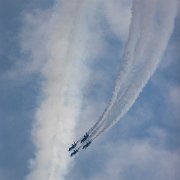
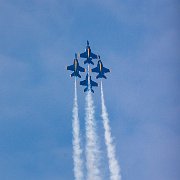
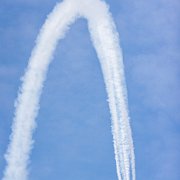
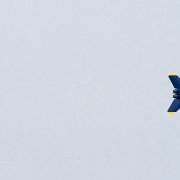
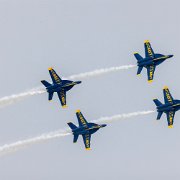
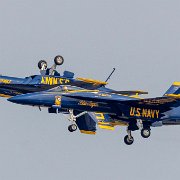
Blue Angels